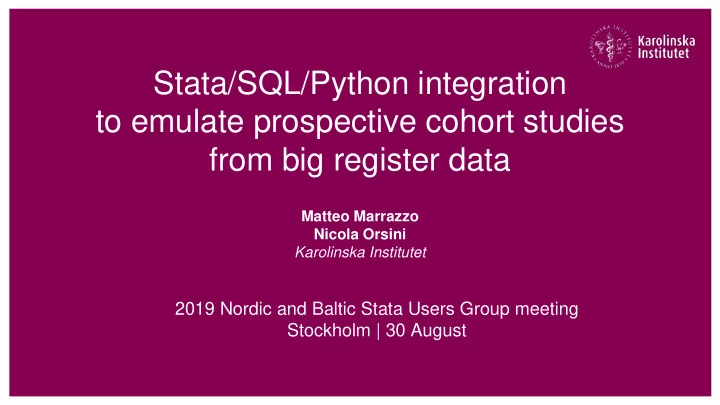

Stata/SQL/Python integration to emulate prospective cohort studies from big register data Matteo Marrazzo Nicola Orsini Karolinska Institutet 2019 Nordic and Baltic Stata Users Group meeting Stockholm | 30 August
Available sources Data registers Big dimensions Covering long periods of time Necessity to develop solid designs 30 augusti 2019 2
Design valid epidemiological studies Prospective cohorts Measuring exposures Defining outcomes Including confounders and effect modifiers Replication in different points in time 30 augusti 2019 3
Relational Databases Structured data SQL language Key data processing ODBC 30 augusti 2019 4
ODBC Stata Integration . odbc list Data Source Name Driver ------------------------------------------------------------------------------ odbc1 ODBC Driver ------------------------------------------------------------------------------ odbc query “odbc1” odbc load, exec(“`query’”) 30 augusti 2019 5
Statistical Analysis Poisson regression models to predict rates ( poisson ) Exposure + effect modifiers + confounders Predictive margins ( margins ) Adjusted rates by exposure 30 augusti 2019 6
Python integration for visualization use "C:\rates.dta", clear python: import numpy as np import pandas as pd import matplotlib.pyplot as plt import seaborn as sns import os os.environ['QT_QPA_PLATFORM_PLUGIN_PATH'] = "C:\\Anaconda3\\Library\\plugins" from sfi import Data X = np.array(Data.get(“exposure rate")) df = pd.DataFrame({'Exposure': X[:, 0], 'Rate': X[:, 1]}) fig, ax1 = plt.subplots() colorset = ["orange","green"] for i in range(0, 2): sns.distplot(df.loc[df['Exposure'] == i, "Rate"], color = colorset[i], label=i, hist=False) plt.ylim(0, 1) plt.legend(title = 'Exposure',loc='upper right', ncol=2, fancybox=True, shadow=True) plt.xlabel('Rate') plt.ylabel('Distribution') plt.show() end 30 augusti 2019 7
Distribution of rates by exposure 30 augusti 2019 8
Animations with python: scatterplot Import libraries and create dataframe from Stata python: import numpy as np import pandas as pd import matplotlib import matplotlib.pyplot as plt import matplotlib.animation as animation import seaborn as sns import os os.environ['QT_QPA_PLATFORM_PLUGIN_PATH'] = "C:\\Anaconda3\\Library\\plugins" from sfi import Data X = np.array(Data.get("day exposure rate")) df = pd.DataFrame({'day': X[:, 0], 'exposure': X[:, 1], 'rate': X[:, 2]}) 30 augusti 2019 9
Animations with python Create the basic plot figure and the function to get x and y fig, ax = plt.subplots(figsize=(16, 9), dpi = 90) ax.set_xlim(0,24) ax.set_xlabel('Month') ax.set_ylabel('Rate') ax.set_ylim(4, 8) ax.set_title('') colorset = ["orange","green"] def get_data(day=0, exposure=0): x = df.loc[(df['exposure'] == exposure) & (df['day'] == day), "day"] y = df.loc[(df['exposure'] == exposure) & (df['day'] == day), "rate"] return x,y 30 augusti 2019 10
Animations with python Create initialization and animation functions # initialization function def init(): for j in range(2): x,y= get_data(day=0,exposure=j) sc = ax.scatter(x,y, c=colorset[j], s=10) return sc, # animation function def animate(i): for j in range(2): x,y= get_data(day=i,exposure=j) sc = ax.scatter(x,y, c=colorset[j], s=10) return sc, 30 augusti 2019 11
Animations with python Run the animation and save the file (‘ffmpeg’ required) Writer = animation.writers['ffmpeg'] writer = Writer(fps=5, metadata=dict(artist='Example'), bitrate=1800) ani = matplotlib.animation.FuncAnimation(fig, animate, init_func=init, frames=25, interval=5000, blit=True, repeat = True) ani.save("Animation.mp4", writer=writer) end 30 augusti 2019 12
Animations with python 30 augusti 2019 13
Conclusions We have shown how it’s possible to integrate Stata with relational databases and python The design, implementation, analysis and visualization can be simplified by taking the best of every software The new python integration in Stata 16 works efficiently and provides a solid base to expand Stata capabilities This integration can provide solutions to increasingly complex research questions 30 augusti 2019 14
Recommend
More recommend